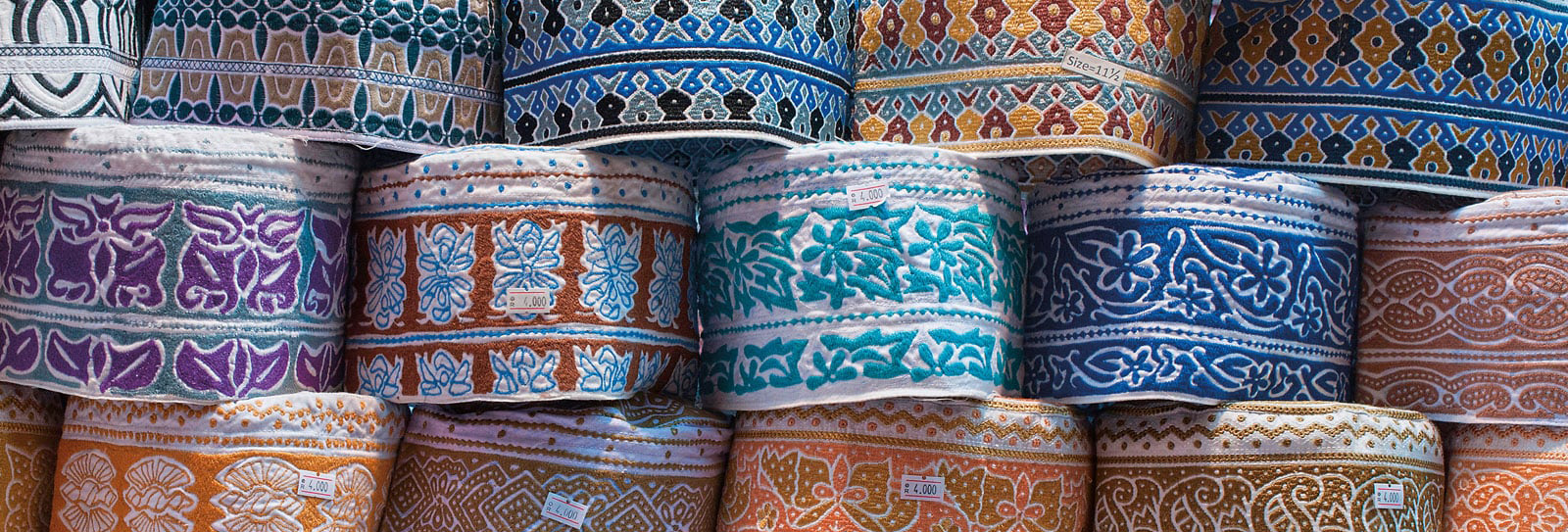
Kummah, the Embroidered Crown of Omani Traditional Dress
Using as its base either calico or other stiff cotton cloth, the kummah is a link to the region's past as well as a personal statement for the present.
From her home in Muscat, capital of Oman, Safiya Ahmad Al Lawati is using peach-colored thread to embroider a cap known in Omani Arabic as a kummah. Pushing her needle through the thick white calico, she works the thread around one of the cap’s dozens of small eyelets that aide ventilation in a hot climate. “I started early this morning,” she explains. “It is a long and complicated process, and it can take up to a month or more depending on how elaborate the decoration is.”



Al Lawati says usually she doesn’t have much time even to make kummahs for her husband and son, as she splits most of her time between overseeing a growing network of scores of women embroidering kummahs throughout Oman and her job as an administrator at The National Museum. “My eyes aren’t as good as they used to be,” she says as she fishes out her glasses. The kummah, she explains, is part of nearly every Omani man’s everyday dress.
“Some customers make requests, and demand is boosted by unique, made-to-measure styles and commissions, but most are content with standard designs,” she says. “It demonstrates pride in our heritage.” Even her five-year-old grandson sports one in the photo she keeps as her phone’s wallpaper.
Using as its base either calico or other cotton cloth stiff enough to stand alone on the head, the kummah is a link to the people of the region’s past as well as a personal statement for the present.
Experts diverge on its origins. Some believe the cap originated in Zanzibar, which was part of the Omani empire for much of the 18th century until 1964. In appearance, it is similar to the traditional kofia of men in East Africa.
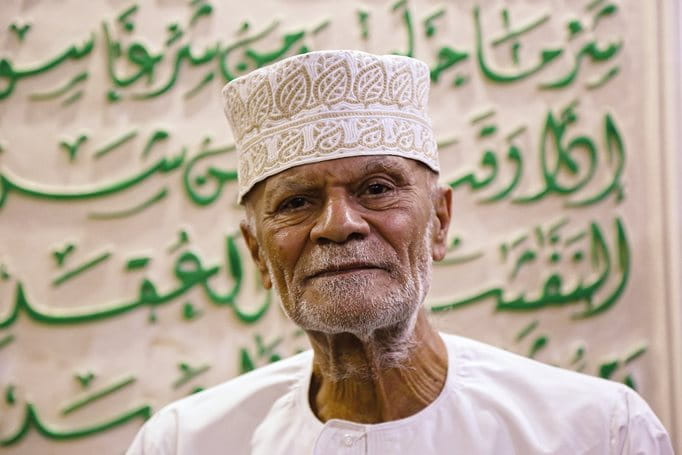
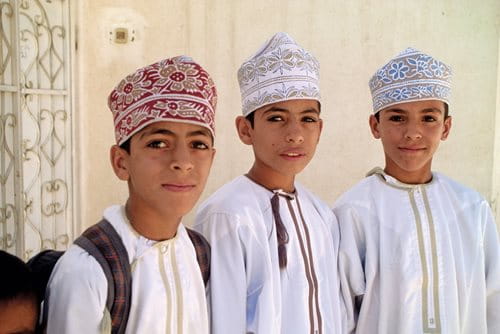
Latif Al Bulushi is the owner of Bait Adam Museum, a private museum in Muscat dedicated to preserving Omani history and culture. For many, kummahs link Omanis to their cultural past and have become a personal statement. Right Kummahs are worn both by children as well as adult men.
“People simply identified kummah wearing with a widespread geographical region.”
—Zulfikar Hirji
Zulfikar Hirji, an associate professor of anthropology at York University in Toronto, says the kummah is “clearly associated with Indian Ocean society,” as both Oman and Zanzibar were parts of “a huge trading community, and dress and costume styles were passed around and picked up,” he explains. “The kummah’s past can never be a cut-and-dried history as there are no written records, few photographs, and people simply identified kummah wearing with a widespread geographical region.”
However, John Gillow, author of African Textiles, believes it was the Omanis who introduced the kummah to East Africa. That is why today, he says, the Omani cap usually has finer work. The Zanzibari varieties, he adds, have more perforations and are found in a more limited range of colors.


The kummah’s popularity today was much enhanced by the late Sultan Qaboos, who ruled Oman for nearly half a century, from 1970 until his death in 2020, and wore a kummah in public.
The structure of a kummah is that of a skull cap with a circular top sewn onto cylindrical sides. The technique used for the eyelets is broderie anglaise, a fine needlework craft incorporating features of embroidery, cutwork and lace. Oman has passed legislation to protect the women who make kummahs against cheap, machine-made imitations so that only caps made in conformity with the regulations can be labeled and sold as authentic kummahs in Oman.
It’s not uncommon for men to amass dozens of kummahs over the years, and even to inherit them.
“I’ve probably got about three dozen,” says Said Al Kithiri, who works as an exhibition designer. “But I haven’t really counted recently. I just pick one up as I leave the house in the morning. Of course I keep my more fancy kummahs for special events such as weddings.”
But the most important personal aspect of a kummah, according to Al Lawati, is that it is made by a female member of the family, which gives her the chance to be artistically creative, show her feelings for the wearer and demonstrate her craft skills.
Al Lawati’s group of kummah makers, scattered throughout the country, is a second wave designing, sewing and embroidering every imaginable style of the ubiquitous cotton cap. The women fit this home working around household duties supplementing the family income and bringing new kummahs into the market: whether the suqs of Muscar or kummahs increasingly ordered online.
At the moment her network is struggling to keep up with demand. Al Lawati is pushing her traditional thick palm needle which she prefers to using a steel needle through the thickness of the raised design to create yet another eyelet. “I answer all their questions and market the finished product. Helping women who aren’t experienced in the demands of kummah making is my role,” she says.


Left Natural light from a window brings out the detail of a blue-on-white kummah. Right A street vendor, having unloaded hundreds of kummahs, finalizes a sell in the backstreets of Muscat, where each kummah’s unique design becomes a personal statement.
“[Kummah making] is a complex process. You have to ensure that the intricate patterns match and that the design flows.”
—Shaikha Rashid Saif Al Battashi

“I’m quite well known in Oman on Instagram as @um.fatmakm, and I like being able to boost my salary and help my family,” she says.
“I’m always looking for new designs,” admits Ahmed Al Syabi as he strolls through Muscat’s central Mutrah suq with two of his cousins. “I take really good care of my kummahs because the best-quality, handmade varieties are expensive. Some can cost hundreds of dollars.” Some in his collection are machine-made and thus much cheaper. “The handmade kummah can be very expensive so there are shops where you can rent for a special occasion like a wedding.”
The Sidabi Women’s charity in old Muscat is the source of much of Shaikha Rashid Saif Al Battashi’s work. Her house is calm as most of her family are out, but her ability to create an outstanding kummah in approximately two weeks is down to having learned the art at the age of eight. Now in her mid-40s, “It’s natural for me to sew in my spare time,” she says. “I’d miss not having anything to do with my hands.” Some of the women who depend on the charity, she adds, are just entering the kummah business, and I am here to help, as it is a complex process. You have to ensure that the intricate patterns match and that the design flows.”
As Al Battashi finishes her task, her teenage daughter enters the room and Al Battashi comments on her daughter liking all things Western. “With the current fashion for long acrylic nails and mobile phones taking up more time, some teenage girls aren’t yet involved in making kummahs, “she says. “But the kummah will go on. It is so elegant, and it adds to our national sense of belonging.”
About the Author

Richard Duebel
Richard Duebel is a filmmaker, photographer and art director who has been working in North Africa and the Middle East for more than 20 years. His interests lie in culture, the environment and the applied arts.
Sylvia Smith
Sylvia Smith makes radio and television programs from the Arab world as well as reports from Europe and elsewhere that explore connections with North Africa and the Middle East.
You may also be interested in...
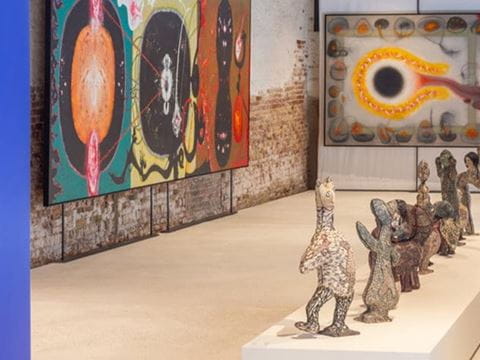
The Resilience of Craft - Three Exhibitions at Venice Biennale Uphold Legacy of Traditional Arts
Arts
The Venice Biennale sheds light on lesser-known narratives outside of the international art world.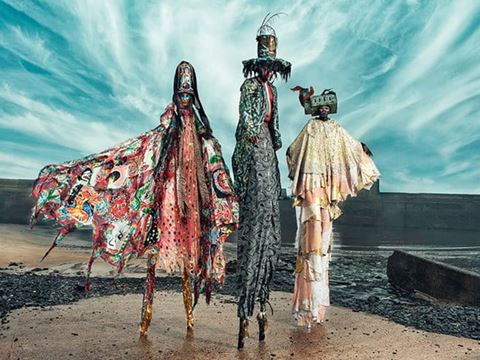
African Artists gain traction in the UK
Arts
The United Kingdom is experiencing a surge in demand for contemporary art of African origin. For artists of the African diaspora, the UK represents a new arena in which to showcase their messages through unique techniques and mediums. Interest in their work follows mounting pressure on museums, universities and other institutions to “decolonize” their curricula and collections.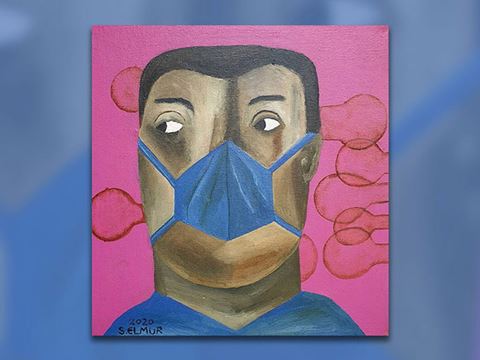
Artists Answer COVID-19
Arts
Amid this year’s travel bans, museum and gallery closures, lockdowns, quarantines, and social distancing, visual artists are responding with fresh imagery and creative collaborations across new platforms to articulate this moment and carry culture forward into the next.

